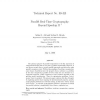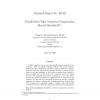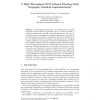5 search results - page 1 / 1 » Parallel Real-Time Cryptography: Beyond Speedup II |
PDPTA
2000
13 years 6 months ago
2000
The primary purpose of parallel computation is the fast execution of computational tasks that are too slow to perform sequentially. However, it was shown recently that a second eq...
ITCC
2000
IEEE
13 years 9 months ago
2000
IEEE
Parallel computers can do more than simply speed up sequential computations. They are capable of nding solutions that are far better in quality than those obtained by sequential c...
ICFP
2007
ACM
14 years 4 months ago
2007
ACM
In this paper we present an automated way of using spare CPU resources within a shared memory multi-processor or multi-core machine. Our approach is (i) to profile the execution o...
ARC
2008
Springer
13 years 6 months ago
2008
Springer
As Field Programmable Gate Arrays (FPGAs) have reached capacities beyond millions of equivalent gates, it becomes possible to accelerate floating-point scientific computing applica...
SCP
1998
13 years 4 months ago
1998
A central challenge in computer science and knowledge representation is the integration of conceptual frameworks for continuous and discrete change, as exemplified by the theory ...



